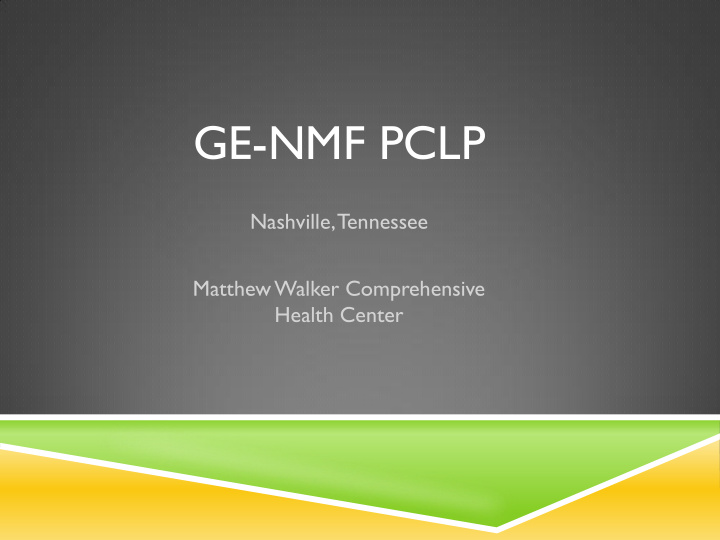



GE-NMF PCLP Nashville, Tennessee Matthew Walker Comprehensive Health Center
Wanda Averhart, B.S. University of Illinois-Urbana Champaign Interested in Pediatrics & Childhood Obesity Prevalence of Obesigenic Feeding Behaviors in New Mothers with Individualized Education on Correct Infant Feeding Practices
Mommy Look At Me Eat!! Expelling Myths & Exposing Truths Infant Feeding Behaviors Survey
Food Choices Activity Level Adult Childhood Obesity Obesity Behaviors Genetics
PURPOSE To decrease the frequency at which parents are participating in those feeding practices that are obesigenic, in order to help with the goals of decreasing the rated of childhood obesity.
METHODS Matthew Walker Comprehensive Health Center Parents of 0-6 month old baby recruited at pediatric and obstetrics clinic via walk-in appointments or over the phone. Pre-survey - 10 questionnaire Discussion of infant feeding and practices Post-Survey - 10 questionnaire Handout given with information discussed
Pre-Survey 1. If I don’t breast feed for at least a year, my baby gets no benefits. If I can’t Breast feed for a year, then I should not start. 2. 3. Breast feeding doesn’t provide any benefits for mom. 4. A big baby is a healthy baby. 5. An empty plate equals a happy plate. 6. Its ok to continue with the bottle up to 2 years old. 7. Adding a little cereal in the bottle increases sleep duration. 8. Its ok to put juice in the bottle. 9. Solid foods can begin as soon as my child is born. 10. When I start giving foods, I can start by giving my baby whatever I’m eating. 11. Babies are not supposed to double their birth weight at 4 months.
Post-Survey 1. My baby and I get benefits from breastfeeding, even if for a short time. 2. It is good to breast feed, even for a short time. 3. I should not pressure feed my baby to make him/her big or to finish his/her plate 4. Its recommended that bottle be weaned around 12 months 5. I should not give my child cereal or juice in the bottle. 6. I should start introducing fruits and veggies at 6 months 7. Babies should double their birth weight at 4 months. 8. Was this session helpful? 9. Will you use information learned in this session? 10. Did you learn something new? 11. Do you feel like that health eating is important?
RESULTS 10 surveys 33% first time mothers 20% recognized all statements as myths on pre-survey On pre-survey at least 60% knew that 8/10 of the myths were false Lowest pre-survey percent was 50, showing more emphasis could be placed on dispelling the myths surrounding an empty plate and juice in the bottle within the community After intervention, on the post-survey, 50% of the ladies identified all the statements correctly.
Results showed that … Question Pre-Survey Percent Correct Post-Survey Percent Correct 1a/1b 100 88.9 2 70 100 3 50 100 4 90 77.8 5 60 88.9 6 50 77.8 7 80 N/A 8 80 N/A 9 90 N/A 10 N/A N/A
LIMITATIONS Question understanding Wording Language barriers Sample size Telephone: Language barrier, disconnected/wrong number, and unanswered calls Appointments: Low frequency, other obligations Analysis Pre-survey versus Post-survey and questions organizing
DISCUSSION Project evolved over time Event Appointment Discussion Telephone Change the selected population Children, new mothers, age limitations Still needed: Program to address obesigenic feeding myths that are present with in the Matthew Walker Community Health Center community
CONCLUSION Projects involving obstetrics should be done at Murphysboro, TN clinic Obstetric only clinic This project will not be on going, but has laid a foundation for others who would like to investigate feeding behaviors among new mothers.
ACKNOWLEDGEMENTS General Electric National Medical Fellows Matthew Walker Comprehensive Health Center University of Illinois – College of Medicine
Recommend
More recommend